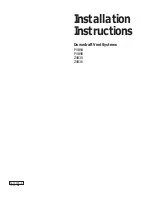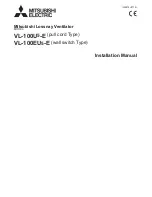
Manual 2100-701
Page
14 of 16
ENERGY RECOVERY VENTILATOR
MAINTENANCE
General Information
The ability to clean exposed surfaces within air moving
systems is an important design consideration for the
maintenance of system performance and air quality.
The need for periodic cleaning will be a function of
operating schedule, climate and contaminants in the
indoor air being exhausted and in the outdoor air being
supplied to the building. All components exposed to
the airstream, including energy recovery wheels, may
require cleaning in most applications.
Rotary counterflow heat exchanges (heat wheels) with
laminar airflow are “self-cleaning” with respect to
dry particles. Smaller particles pass through; larger
particles land on the surface and are blown clear
as the flow direction is reversed. For this reason,
the primary need for cleaning is to remove films of
oil-based aerosols that have condensed on energy
transfer surfaces. Buildup of material over time may
eventually reduce airflow. Most importantly, in the
case of desiccant-coated (enthalpy) wheels, such films
can close off micron-sized pores at the surface of the
desiccant material, reducing the efficiency with which
the desiccant can absorb and desorb moisture.
Frequency
In a reasonably clean indoor environment such as a
school, office building or home, experience shows that
reductions of airflow or loss of sensible (temperature)
effectiveness may not occur for 10 or more years.
However, experience also shows that measurable
changes in latent energy (water vapor) transfer can
occur in shorter periods of time in commercial,
institutional and residential applications experiencing
moderate occupant smoking or with cooking facilities.
In applications experiencing unusually high levels
of occupant smoking, such as smoking lounges,
nightclubs, bars and restaurants, washing of energy
transfer surfaces, as frequently as every 6 months,
may be necessary to maintain latent transfer efficiency.
Similar washing cycles may also be appropriate for
industrial applications involving the ventilation of high
levels of smoke or oil-based aerosols such as those
found in welding or machining operations, for example.
In these applications, latent efficiency losses of as
much as 40% or more may develop over a period of 1
to 3 years.
Cleanability and Performance
In order to maintain energy recovery ventilation
systems, energy transfer surfaces must be accessible
for washing to remove oils, grease, tars and dirt that
can impede performance or generate odors. Washing
of the desiccant surfaces is required to remove
contaminate buildups that can reduce absorption of
water molecules. The continued ability of an enthalpy
wheel to transfer latent energy depends upon the
permanence of the bond between the desiccant and
the energy transfer surfaces.
Bard wheels feature silica gel desiccant permanently
bonded to the heat exchange surface without
adhesives; the desiccant will not be lost in the washing
process. Proper cleaning of the Bard energy recovery
wheel will restore latent effectiveness to near original
performance.
Maintenance Procedures
NOTE:
Local conditions can vary and affect the
required time between routine maintenance
procedures; therefore, all sites (or specific
units at a site) may not have the same
schedule to maintain acceptable performance.
The following timetables are recommended and
can be altered based on local experience.
Quarterly Maintenance
1. Inspect mist eliminator/prefilter and clean if
necessary. This filter is located in the fresh air
intake hood on the front of the unit. This is an
aluminum mesh filter and can be cleaned with
water and any detergent not harmful to aluminum.
2. Inspect wall mount unit filter and clean or replace
as necessary. This filter is located either in the
unit, in a return air filter grille assembly or both.
If in the unit it can be accessed by removing the
lower service door on the front of the unit. If in a
return air filter grille, by hinging the grille open to
gain access.
3. Inspect energy recovery ventilator for proper wheel
rotation and dirt buildup. This can be done in
conjunction with Item 2 above. Energize the energy
recovery ventilator after inspecting the filter and
observe for proper rotation and/or dirt buildup.
4. Recommended energy recovery wheel cleaning
procedures follow: Disconnect all power to
unit. Remove the lower service door of the wall
mount unit to gain access to the energy recovery
ventilator.
5. Remove the front access panel on the ventilator.
Unplug amp connectors to cassette motors. Slide
energy recovery cassette out of ventilator.
6. Use a shop vacuum with brush attachment to clean
both sides of the energy recovery wheels.
7. Reverse shop vacuum to use as a blower and blow
out any residual dry debris from the wheel.
NOTE:
Discoloration and staining of the wheel does
not affect its performance. Only excessive
buildup of foreign material needs to be
removed.


































